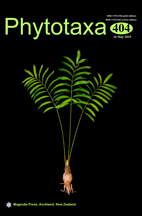Abstract
A new species of Mesosetum with a winged rachis, only known from Serra da Canastra, Minas Gerais, Brazil, is described and illustrated. The new species (Mesosetum canastrense) is morphologically similar to M. alatum, but it is distinguished mainly by the collar with a continuous line of trichomes (vs. absent or interrupted in M. alatum), synflorescences 6‒9(‒12) cm long (vs. 2.2‒3.2(‒7.5) cm long), pedicels with a truncate apex (vs. oblique), spikelets with the base surrounded by long appressed trichomes 0.8‒1.2 mm long (vs. glabrous or with short sparse trichomes ca. 0.2 mm long) and with an inconspicuous callus (vs. conspicuous and geniculate), and the lower anthecium neuter (vs. staminate or neuter). Additionally, the two species also differ in geographical distribution, since M. alatum only occurs in the Brazilian state of Mato Grosso.

